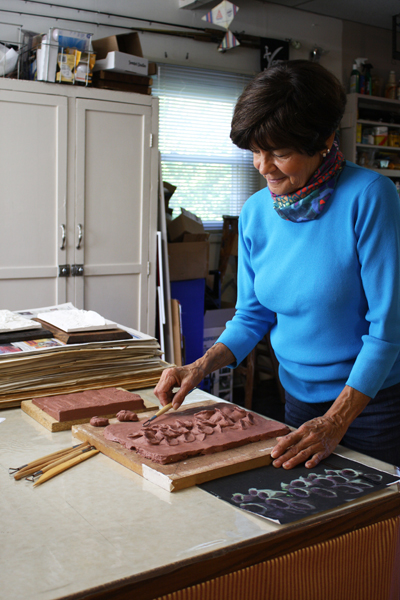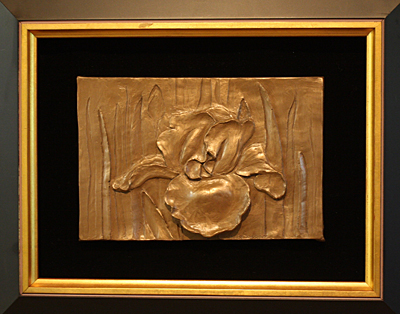Mary Button: Turning Paintings into Bronze Relief Sculptures
 Artist Mary Button at work.
Artist Mary Button at work.Photograph by Jennifer Hetrick.
For more than three decades, Mary Button focused her talents on canvas with oils and acrylics. But 12 years ago, she began to embrace her paintings in a new form by translating them into bronze relief sculptures.
Curious to finally explore more three-dimensional art, Button studied under metal sculptor Richard Summons of Sinking Spring, not far from her in Southeastern Pennsylvania.
“You start with carving clay,” Button says.
She works from copies of her original paintings, building up non-firing clay to mimic the scenes, and then cuts away what she needs to in order to accurately replicate her two-dimensional art in three-dimensional form.
And since a lot of sculptors create an original piece of art in the moments of meeting clay with their hands, Button’s approach of giving her paintings a chance to be expressed in a different medium is, in itself, a way to honor what came first.
Her garden and grandchildren as well as historic structures she painted from a family trip to Italy to meet relatives she hadn’t known before are just some of the subjects which Button has conveyed through brushstrokes and turned into bronze sculptures.
A nighttime cityscape of Philadelphia which Button painted in the past became a bronze relief sculpture in her collection. In it, she relocated the moon as a means to give it better placement as a focal point.
While she sometimes works with cold forms of steel, Button says about 60 percent of her work is completed in bronze powder mixed with a resin. It is shaped through a latex mold which holds her design in the non-firing clay which she reuses.
Button contracts Summons to do her final casting work, because his larger studio is better equipped to handle the final stages of her process.
 Finished bronze relief sculpture by Mary Button.
Finished bronze relief sculpture by Mary Button.Photograph by Jennifer Hetrick.
“I like that it’s so convenient and can be done in a studio rather than a foundry,” Button says about bonded bronze compared to the more typical process of heating bronze for castings.
“And I like the finish, shine and feel of the completed metal,” she adds.
Still life paintings rebirthed in bronze and slightly larger sculptures not necessarily with perfectly straight edges but more organic outer sections are a part of the latest evolution of Button’s art.
A more recent piece by Button is a painting-turned-sculpture of foxglove petals, giving attention to this biennial’s low-hanging, open bell-like flowers and the speckled patterns inside of them.
In 2015, Button received the Jack Coggins award for Creativity, Innovation and Service to the Art Community. This honor also included a solo show at the Yocum Gallery at the Yocum Institute for Arts Education in Wyomissing.
Button’s appreciation for art has led her to volunteer for different nonprofits across Berks County, where she resides, in addition to participating in varied shows.
Her art has been a part of exhibits through the Berks Art Alliance, Senior Festival of the Arts at Reading Area Community College, Freyberger Gallery at the Penn State Berks campus, Jewish Cultural Heritage Center of Reading and Studio B, to name just a handful of venues which have displayed her works.
“It gives me a more permanent effect of what I’m trying to convey with my subjects,” Button says about the opportunity to recreate her paintings in bonded bronze.
Resources:
Also in this Issue:
- The Arizona Copper Museum: Paying Homage to the Country’s Rich Copper Roots
- Shahna Lax: Expressing the Sacred Through Copper
- Restoring Copper Heirlooms for Future Generations
- Mary Button: Turning Paintings into Bronze Relief Sculptures
- Larry Frazier Bronze Works on View at Robert Kuo Gallery
